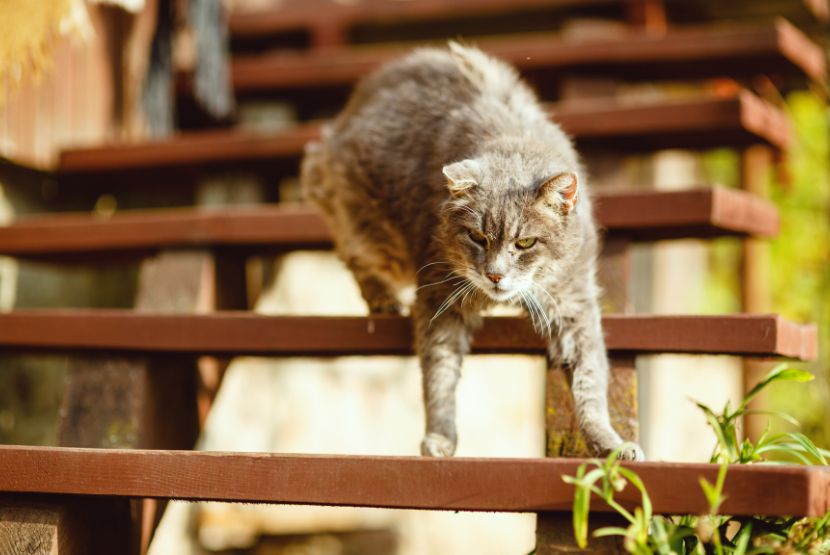Is your senior cat less active or playful than a few years or months ago? Despite common belief, slowing down isn’t a natural aging sign, but instead is a common arthritis indicator that suggests your cat may be trying to minimize their pain and discomfort from inflamed joints.
Fortunately, arthritic cats don’t have to suffer in silence. Early diagnosis, modern treatment options, and simple at-home modifications can restore your cat’s mobility and help them enjoy a better quality of life.
Feline arthritis: A well-hidden health crisis
While most pet owners know about arthritis in dogs, few are aware that cats suffer from the exact same condition. A radiographic (i.e., X-ray) study showed that 90% of cats over 12 years old had arthritic changes in their bones and joints, suggesting an extremely high disease prevalence among the average feline population.
Unfortunately, because cats instinctively hide pain and weakness to protect themselves from predators, most owners don’t realize that their beloved pet is in pain. Additionally, because cats are more stressed and fearful during veterinary visits, veterinarians have difficulty detecting changes in a cat’s gait, stance, or joint range of motion (e.g., flexibility).
Subtle signs: Identifying pain in cats
Feline medicine experts have identified many pain indicators in cats. You should familiarize yourself with these signs and behaviors so you can identify your cat’s pain more quickly, and seek prompt veterinary care and, ideally, more effective treatment.
Pain signs can include:
- Postural changes — Cats may crouch, stand with an arched back, shift weight, or be restless.
- Increased sleeping — Painful cats may sleep more to avoid painful movement and as a coping mechanism for stress.
- Unusual facial expression — Painful cats may squint their eyes, tense their muzzle, and rotate their ears outward, which can look like a grimace.
- Isolation — Painful cats may be frightened or stressed, which drives them to hide.
- Avoiding physical contact — Painful cats may dodge petting or run away to avoid being picked up.
- Personality changes — Painful cats may become more irritable, aggressive, or seek more attention (i.e., clinginess). Formerly playful cats may seem disinterested in their favorite toys or companions.
- Unusual movement patterns — Cats may avoid slick surfaces, high jumps, or staircases to protect themselves from pain or injury, which may look like taking an alternate route or avoiding specific areas.
- Litter box changes — Stiff or painful cats may struggle to step in or out of a traditional litter box, and will eliminate nearby to avoid the pain.
- Vocalizing — Painful cats may express themselves vocally with persistent crying or, in the case of acute (i.e., sudden) pain, a sharp, sudden yowl.
- Increased or decreased grooming — Painful cats may groom obsessively or stop grooming altogether.
Smooth moves: Work with your veterinarian to improve your cat’s mobility
If your cat is displaying pain signs, schedule an appointment with your regular veterinarian to discuss your concerns. Your veterinarian will use your information, along with any findings from your cat’s physical examination, to determine if arthritis is the cause. After ruling out other conditions, your veterinarian will present various treatment options to minimize your cat’s pain and improve their mobility. Such a plan may include:
Medication — In the past, medication options for cats were severely limited and often came with undesirable risks or side effects. Fortunately, a convenient monthly injectable medication designed to control arthritis signs in cats is now available at most veterinary hospitals.
- Weight loss — Extra weight can increase pressure on your cat’s painful joints. Your veterinarian can design a safe weight loss plan that prioritizes high-quality nutrition.
- Pain management modalities — Non-pharmaceutical therapies can be immensely helpful in managing feline arthritis. Laser therapy and acupuncture, which many cats tolerate well, can effectively block or disrupt the body’s pain signaling. Some cats may also benefit from heat therapy (e.g., a warming bed or therapeutic light pad), but use these with caution to prevent burns.
Creature comforts: Easy at-home modifications to reduce arthritis pain in cats
In addition to prescribed therapies, you can improve your cat’s comfort with simple modifications to their environment. Examples include:
- Increasing accessibility to resources — Ensure your cat’s food, water, litter box, and bed are always within easy walking distance. You may need to set up additional stations.
- Providing ramps and non-slip mats — Help your cat access their preferred resting places with furniture ramps and non-slip rugs to ensure a soft, secure landing.
- Treating your cat to a supportive bed — Your cat’s bed should provide firm, even support, be easy for them to enter and exit, and be placed in a central but safe area away from cold drafts.
- Lowering the litter box entry — Cut a lower door in your cat’s litter box so they can walk—not climb—in. Wrap any trimmed edges with duct tape to prevent injury.
- Providing elevated food and water stations — Cats must flex their shoulders, elbows, hips, knees, and neck to crouch, so provide elevated stations that allow them to maintain a more neutral posture.
Don’t allow feline arthritis to limit your cat’s quality of life. If you notice your senior cat slowing down or displaying other unusual behaviors, contact your regular veterinarian to explore treatment options.
The aging process is different for every pet, which can leave caring owners with unexpected challenges, questions, and concerns. Let us help. The Nebraska Pet Hospice team is dedicated to providing comfort, compassion, and dignity for your pet during their golden years and their final days. Contact our caring team to discuss your pet’s unique needs or learn more about our services.


